Suspended Animation #307
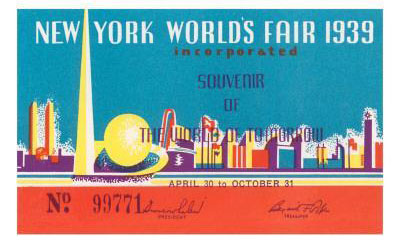
Disney had a prominent presence at the 1939-1940 New York World’s Fair that had some elements that many think influenced some aspects of Epcot.
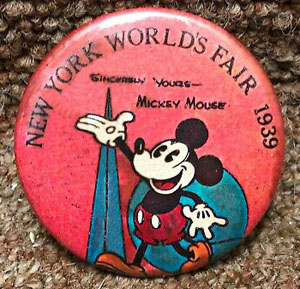 The 1939-1940 New York World’s Fair, located on the current site of Flushing Meadows-Corona Park was also the location of the later 1964-1965 New York World’s Fair, and was one of the largest world’s fairs of all time. More than 44 million people attended its exhibits in its two seasons.
The 1939-1940 New York World’s Fair, located on the current site of Flushing Meadows-Corona Park was also the location of the later 1964-1965 New York World’s Fair, and was one of the largest world’s fairs of all time. More than 44 million people attended its exhibits in its two seasons.
There was also the competing Golden Gate International Exposition in San Francisco. Sponsored by eleven of the Western states of the United States and 28 foreign countries, this “World’s Fair of the West” was built on Treasure Island, a man-made island in San Francisco Bay.
The 1939 World’s Fair in San Francisco was the first known World’s Fair that Walt Disney attended. He visited at least four others during his lifetime, including the 1962 one in Seattle. Walt said there would be “Space Needles cropping up all over after the success of this one,” proving that even Walt was not always right.
A round pin for the 1939 New York World’s Fair was issued with Mickey walking and waving in front of the Trylon and Perisphere and a Mickey Mouse wristwatch was buried in the time capsule.
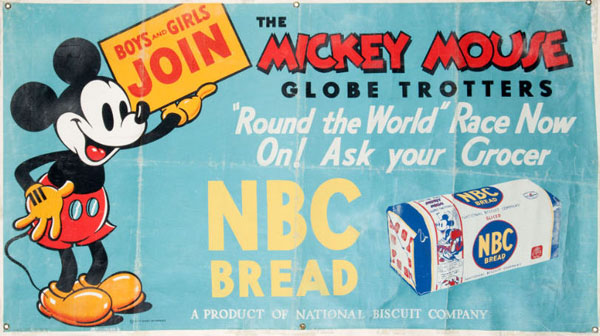
Mickey Mouse and Nabisco
Both of the 1939 New York World’s Fair venues had exhibits sponsored by the National Biscuit Company (Nabisco) that presented a very special Technicolor Mickey Mouse short cartoon titled Mickey’s Surprise Party.
The N.B.C. National Biscuit Company Magazine issue of January-February 1939 (Volume 26, Number 1) has an article titled “N.B.C. Theaters at New York and San Francisco World’s Fairs.”
Here is an excerpt:
“In New York, we have a circular space in Food Building North, and are erecting an air-conditioned motion picture theater seating approximately 266 persons.
“On Treasure Island, in San Francisco Bay our Company has erected a modern motion picture theatre in the Food and Beverages building. The theatre is rectangular in shape with rounded corners, and seats about 130 persons. There will be no charge to either theatre. At both Fairs, the N. B. C. screen program will be the same.”
Mickey’s Surprise Party produced for National Biscuit Company might be considered one of the very first “infomercials.”
Obviously a lot of money was spent on this cartoon, since the color is much richer than some of the other Mickey cartoons at the time and when Mickey first appears on Minnie’s front porch there is shadowing (even around Mickey’s nose) that doesn’t appear in other Mickey cartoons of the time because of the labor and expense. It helped make the characters look more three-dimensional.
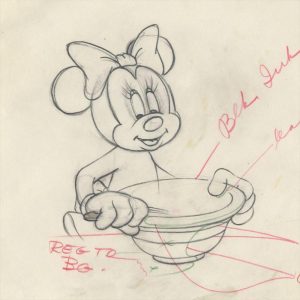 Minnie Mouse and her dog, Fifi, are in the kitchen with Minnie stirring a bowl because they are going to “surprise Mickey with some cookies like his mother used to make.”
Minnie Mouse and her dog, Fifi, are in the kitchen with Minnie stirring a bowl because they are going to “surprise Mickey with some cookies like his mother used to make.”
When Minnie leaves the room, Fifi barks to shoo away an annoying fly from the batter. When Fifi gives chase, she accidentally knocks an entire box of uncooked popcorn into the batter.
Mickey is curious what surprise Minnie has planned as she sits coyly at the piano.
Suddenly, there is the smell of smoke of burning cookies.
Mickey scoops up a bug sprayer and fills it with water from the gold fish bowl, leaving just enough for the poor fish. Using the sprayer and hiding behind an overturned table, Mickey battles valiantly against the exploding (because the popcorn inside them is now popping) and burnt cookies.
Minnie is distraught and collapses into tears on the living room couch while Fifi howls. Her surprise party for Mickey is ruined.
Minnie cries that “I wanted to make them the way your mother did.” Mickey tries to comfort her with his flippant response: “Aw, my mother used to burn the whole batch all the time!”
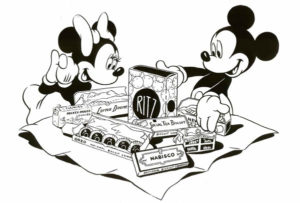 Mickey suddenly gets an idea and he and Pluto zoom out of the house.
Mickey suddenly gets an idea and he and Pluto zoom out of the house.
They return shortly with a variety of Nabisco cookies: Lorna Doones, Fig Newtons, Social Tea Biscuits, Ritz Crackers, Oreos, and Animal Crackers.
Pluto has even brought Milk Bone Dog Biscuits for Fifi.
“Mother used to buy them all the time and here’s my favorite!” says a happy Mickey as he offers Minnie a Fig Newton. Minnie smothers Mickey with kisses and the film fades out on the Nabisco logo. It’s the only cartoon that talks about Mickey’s mother or gives concrete evidence that he eats other things than cheese.
A censored version of this cartoon eliminating specific product references appears on The Spirit of Mickey video although an uncensored one appears on the Disney Treasures Mickey Mouse in Living Color DVD.
The roughly five-minute cartoon was directed by Ham Luske with animation by Ollie Johnston, Walt Kelly (yes, the father of Pogo), Riley Thompson, Charles Nichols and, of course, Walt Disney doing the voice of Mickey.
While The Pointer (1939) is officially credited as the first appearance of pupils in Mickey’s eyes, this film released several months before that film features Mickey with pupils.
The cartoon was officially delivered to Nabisco on February 18th, 1939, and Disney was paid $41,000 for its production. The National Biscuit Company had actually started producing the popular selling Mickey Mouse cookies starting in 1937.
For more production information on Mickey’s Surprise Party, see J.B. Kaufman’s excellent post on Cartoon Research here.
Donald Duck Day
Not to be outdone, Donald Duck made an appearance at the fair was well. He was especially flown in from Hollywood for a special Donald Duck Day event held August 14, 1939.
Since this was in the years before Disney developed costumed walk-around characters, Donald was a 3-foot-tall model that was occasionally used for public appearances.
 He arrived at the Fair at noon that day. He was just in time to attend the official premiere of his latest cartoon, Donald’s Penguin (1939), even though the short had been released to theaters three days earlier.
He arrived at the Fair at noon that day. He was just in time to attend the official premiere of his latest cartoon, Donald’s Penguin (1939), even though the short had been released to theaters three days earlier.
Admiral Byrd (spelled as “Bird” in the cartoon as a gag) ships Donald a gift of a baby penguin from the South Pole and, of course, the cute penguin proves to be nothing but trouble. This cartoon and its showing at the fair were meant to tie in with the Admiral Byrd Penguin Island exhibit in the Amusement Zone at the fair.
That day, the short was shown every half hour from noon to 6 p.m. at the National Biscuit Theatre in the Food Pavilion in place of Mickey’s Surprise Party.
At 12:15 p.m., Donald’s helpers handed out gifts to the first 500 lucky children and met comedienne and singer Judy Canova (picture below).
At 12:30 p.m., Donald was paraded past the Perisphere accompanied by marching bands and other entertainers.
The parade concluded at 1 p.m. at Carnivaland, where a special luncheon was held at the Children’s World Restaurant for Donald and international children.
Carnivaland was located in the Fair’s amusement area zone that was adjacent to Fountain Lake.
At 2 p.m., Donald was presented with a honorary degree of Doctor of International Friendship from Dr. Frank Monaghan, a professor of American History at Yale University.
In his speech, Monaghan noted that Donald, “never pretended to be a statesman, nor an ambassador nor even a politician; he has only wanted to be and has only been himself. But his antics and his quacks are more sensible and inspired than the grave nonsense of many who pretend to higher things. He has given the world joy through laughter; he is the ambassador extraordinary of good will to the world.”



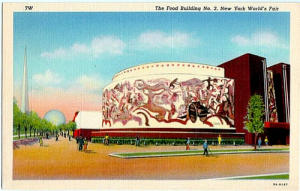
 Jim Korkis is an internationally respected animation historian who in recent years has devoted his attention to the many worlds of Disney. He was a columnist for a variety of animation magazines. With his former writing partner, John Cawley, he authored several animation related books including The Encyclopedia of Cartoon Superstars, How to Create Animation, Cartoon Confidential and Get Animated’s Animation Art Buyer’s Guide. He taught animation classes at the Disney Institute in Florida as well as instructing classes on acting and animation history for Disney Feature Animation: Florida.
Jim Korkis is an internationally respected animation historian who in recent years has devoted his attention to the many worlds of Disney. He was a columnist for a variety of animation magazines. With his former writing partner, John Cawley, he authored several animation related books including The Encyclopedia of Cartoon Superstars, How to Create Animation, Cartoon Confidential and Get Animated’s Animation Art Buyer’s Guide. He taught animation classes at the Disney Institute in Florida as well as instructing classes on acting and animation history for Disney Feature Animation: Florida.




















































Oh great, now I’m hungry for Fig Newtons….
Mickey occasionally ate things other than cookies and cheese. For example, in “Building a Building” (1933), Minnie gives him a box lunch of “baloney, and macaroni, and some fresh strawberry pie.” That “Box Lunch” song has stuck fast in my memory ever since I first saw the cartoon on “The Mouse Factory”.
The pool hall on Pleasure Island in “Pinocchio”, made up of a giant 8 ball and adjacent standing pool cue, looks very much like the Trylon and Perisphere of the 1939 World’s Fair.
And of course, the World’s Fair inspired the Fleischer Color Classic “All’s Fair at the Fair”, in which rubes Elmer and Miranda and their horse Dogbiscuit are wowed by demonstrations of automation and robotics, which no doubt would have interested Max Fleischer greatly. The cartoon is basically a more sophisticated version of “Betty Boop’s Crazy Inventions”, minus Betty and all the funny animals.
I first saw “Building a Building” on The Mouse Factory as well! But I thought Minnie sang about a huckleberry pie.(If I mis-heard or misunderstood, it wouldn’t be the first time.) I like the way Mickey dots the i at the end. One of the best Disney iris-outs for my money.
And speaking of buildings, I wouldn’t be surprised if the structures on Pleasure Island owed some of their design to the 1939 fair.
“All’s Fair at the Fair” is one of my favorite Fleischer classics. Not because it’s all that funny (it isn’t) but the machinery is so amazing. I like the makeovers of Elmer and Mirandy by the end. They transform from stereotypical country bumpkins to rather nicely-designed characters and it’s fun to see how the machinery brings that about.
Great that we’re both fascinated by the same cartoons. The ones you cited are special favorites of mine as well.
I’m sure it was strawberry pie, Frederick, because I had never tasted any, and I remember my mother explaining that they tended to be runny and soggy. I also remember how my sister gushed like, well, like a little girl when Mickey dotted the “i” at the end. My mother remembered “Building a Building” from her own childhood and was delighted to watch it with her family again after all those years.
You’ve identified an important subtext to “All’s Fair at the Fair”: the idea that a World’s Fair not only makes for a pleasant day out but also, if done right, can palpably improve people’s lives. There’s no telling how many exhibits and displays may have sparked an interest that inspired a lifelong passion, pursuit or even career. I’m sure this was never far from Walt Disney’s mind when planning his theme parks.
“Here’s Grover Whalen/unveilin’/the Trylon/Over on the West Coast/we have/Treasure Islon..” — Groucho Marx via Harburg and Arlen.
To be sure, the Fleischers had their own tip of the hat to the fair as well…
That is Judy Canvoa giving Donald Duck a hug in that black-and-white publicity shot.
What a great piece! I’ve had a ravenous interest in those 1939 World’s Fairs for years now. I never knew about the Disney tie-ins. And my daughter and I did notice the name brands in that Mickey cartoon (Spirit of Mickey version), and were scratching our heads recently over it.
By the way, here’s an article with the images of a truly wonderful Milt Gross comic about the 1939 NY Fair – complete with a cartoon map. It’s really a masterpiece!
https://www.theatlantic.com/entertainment/archive/2015/04/rediscovering-a-comic-masters-lost-masterpiece/389117/
I’m hoping that someday we’ll find newsreel footage of E.C.Segar at the Chicago World’s Fair form 1933 – or was it the “Century of Progress” from the following year, 1934. I heard rumors that either Paramount or Hearst’s newsreels took some footage of him from there, but I’ve never been able to verify it.
Segar’s run of large format strips for two weeks or so in ’33 depicting the Thimble Theatre cast at the Chicago World’s Fair were pretty delightful.
Those strips can be seen in “E.C. Segar’s Popeye Volume 3: Let’s You And Him Fight.”
Also at the 1933 Chicago World’s Fair, a local radio station interviewed some of the attendees, and one eighteen-year-old from Alabama proved so funny and entertaining that the station offered him a job. Thus began the show business career of Pat Buttram, who later played Mr. Haney on “Green Acres” and voiced characters in “The Aristocats”, “Robin Hood”, and other animated Disney features.
I wonder if we’ll ever get an official release of films made for the theme parks, such as:
— “Return to Neverland”with Walter Cronkite and Robin Williams. My fantasy is a disc that includes the short gags used to present each department, and the post-show of animators trying to dance like the dogs at the end of “Oliver and Company”.
— “Mickey’s Big Break”, a live action film with an animated Mickey going to Hollywood.
— A similar short with Mickey and Michael Eisner going to a screening room, which served as intro to current trailers.
— All the live action videos from the old studio tour, including Bill Cosby doing the “I’m going to Disney World” line plus PeeWee Herman and Mel Gibson teamed up to talk about sound effects. Not holding my breath for that disc.
— Some kind of presentation of “Cranium Command”, which was mostly a film attraction.
— “Captain Eo” and the Mouseketeer 3D film. I know the latter is mainly a couple of theatrical shorts with some Mouseketeer padding, but still.
It’s not totally unheard of. Universal released “Shrek 3D” and the “Back to the Future” ride as bonuses with the movies.
I made a comparison video for “Mickey’s Surprise Party”.
https://www.youtube.com/watch?v=SgccuksL7ec
I have provenience for a collection of Disney-style cartoon vignettes (one features Mickey and Minnie Mouse) created in postwar Berlin, dated and signed by a German/American artist. Do you have information about Disney animator’s who served in the army or who were sent to Germany during this time period? Can you recommend an appraiser? Thank you for responding to my inquiry by using the provided Email address.